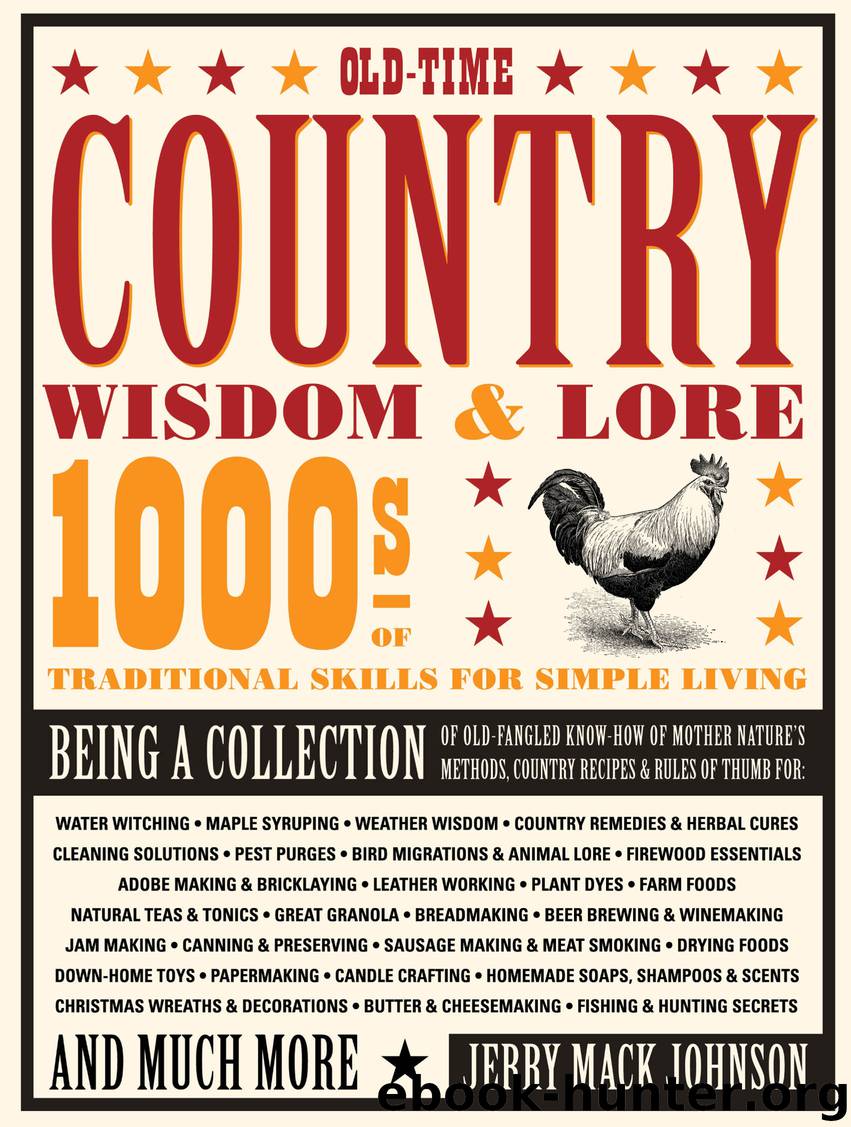Old-Time Country Wisdom & Lore by Jerry Mack Johnson

Author:Jerry Mack Johnson
Language: eng
Format: epub
Publisher: MBI
Published: 2011-08-26T16:00:00+00:00
After determining the stabilizer-soil ratio, you can estimate what amount is needed for each mixer load according to the soil capacity of the machine in cubic feet. It’s a good idea to use a bit more emulsified asphalt than the minimum required in testing, since conditions may alter somewhat during production. Always allow sufficient time for the stabilizer to thoroughly mix with the mud.
Molds
Make your molds from Douglas fir lumber. Besides being a strong wood, it holds screws and nails better than redwood or pine. Use fine-grained, finished wood. Rough lumber is difficult to separate from the wet bricks.
Molds range in size from 8 inches square and 2 inches thick to 2 yards long, 1 foot wide, and 6 to 8 inches thick. However, the standard dimensions for an adobe brick are 4 by 7 1/2 by 16 inches. So that the finished brick will be 4 inches thick, make the mold depth 4 1/4 inches to compensate for slight sagging of the mud as the mold is removed and to allow for some shrinkage during drying.
Cut four boards of the proper size and waterproof them.
For a stronger mold, fasten the boards with wood screws instead of nails. Reinforce each mold with two comer braces located diagonally from one another. Countersink them so that they are flush with the wood’s surface.
At each end of the form, add wooden rectangles of a convenient size to serve as handles.
Tack a thin metal strip on the top edges of the form to prevent wear as your trowel scrapes away excess mud after the mold has been filled. For ease in separating the mold from the mud, either line the form with a thin sheet of tin or make the mold’s bottom 1/16 inch wider on each side.
Making Adobe Bricks
Necessary Equipment:
• rectangular mason’s trowel
• wooden molds
• pick (for hard earth)
• two shovels: a pointed one for digging soil; a square one for shoveling mud
• deep wheelbarrow
• containers for the stabilizer
• buckets
• large drum for storing water
• mechanical mud mixer equipped with paddles (A dough, plaster, or pug mixer works well; a concrete mixer is not satisfactory.)
This piece of equipment is essential if your bricks are intended for any type of building and will, therefore, require emulsified asphalt. For other purposes not requiring a stabilizer, the ingredients can be deposited in a pit and trampled and mixed with your bare feet.
Casting surfaces: You can cast bricks on flat ground, but a smooth surface is preferable. Use boards or scrap plywood supported on a framework of two-by-fours.
Shading material: If you plan to dry bricks out of the sun, provide shade with plywood supported several inches above the bricks.
Download
This site does not store any files on its server. We only index and link to content provided by other sites. Please contact the content providers to delete copyright contents if any and email us, we'll remove relevant links or contents immediately.
Periodization Training for Sports by Tudor Bompa(7916)
The MacArthur Bible Commentary by John MacArthur(4649)
The Body: A Guide for Occupants by Bill Bryson(4580)
The Sports Rules Book by Human Kinetics(4077)
What It Really Takes to Get Into Ivy League and Other Highly Selective Colleges by Hughes Chuck(3551)
Marijuana Grower's Handbook by Ed Rosenthal(3511)
The Sprouting Book by Ann Wigmore(3408)
The Martian by Andy Weir(3181)
Salt, Fat, Acid, Heat: Mastering the Elements of Good Cooking by Nosrat Samin(2996)
The Bread Bible by Rose Levy Beranbaum(2885)
Sapiens and Homo Deus by Yuval Noah Harari(2842)
Classic by Mary Berry(2831)
Harry Potter 4 - Harry Potter and The Goblet of Fire by J.K.Rowling(2799)
The Marketing Plan Handbook: Develop Big-Picture Marketing Plans for Pennies on the Dollar by Robert W. Bly(2792)
Martha Stewart's Baking Handbook by Martha Stewart(2669)
Screenplay: The Foundations of Screenwriting by Syd Field(2434)
The Plant Paradox by Dr. Steven R. Gundry M.D(2425)
50 Economics Classics by Tom Butler-Bowdon(2409)
The Cambridge Grammar Of The English Language by Rodney Huddleston Geoffrey K. Pullum(2316)
